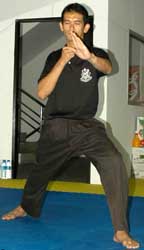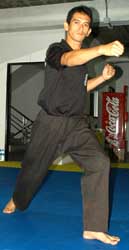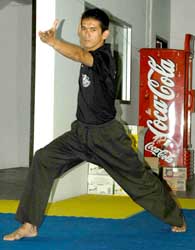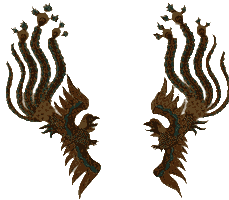Competition Maneuvers of Keluarga Pencak Silat Nusantara (IV)
Rapid Journal, Vol 7, No.4 (Book 26, 2003: 44 – 45)
© O'ong Maryono
www.kpsnusantara.com
Demonstrated by Muhammad Ibnu Rodi, trainer KPS Nusantara Nonthaburi, Thailand
 |
 |
 |
fig.1 |
fig.2 |
fig.3 |
Here we continue exploring the KPS Nusantara competition maneuvers briefly describing the fourth sequel or jurus pertandingan IV, as performed by Muhammad Ibnu Rodi, trainer KPS Nusantara Nonthaburi, Thailand. When compared to the maneuvers in jurus perandingan III you will notice that there are many similarities and the differences mostly lies in the order of movements resulting in different degrees of difficulty.
Defense Tactics
 |
 |
 |
 |
fig.4 |
fig.5 |
fig.6 |
fig.7 |
The pesilat stands in position I (fig. 1) before moving to standing position XII (sikap dua belas: fig. 2). This standing position signals that the pesilat is ready to fight. From this position the pesllat enters into action by slowly opening the left and right palm, the right leg pulled up in the so-called "white heron" standing position (sikap dua) as to invite the opponent's attack (fig. 3). Subsequently, the pesilat returns to standing position XII by pulling down the right foot and moving closer the left foot forming a triangle shaped step (langkah segi tiga:
fig. 4). From this position the pesilat can decide to attack the opponent.
Attack Tactics
 |
 |
 |
 |
fig.8 |
fig.9 |
fig.10 |
fig.11 |
From standing position XII the pesilat advances with a left front kick (fig. 5) followed immediately by a rapid landing of the left foot and a front punch with the right hand (fig. 6) and again a side kick with the right leg (fig. 7). After the right leg returns to position the leg moves in zigzag forward and a strong punch is given with the left arm (fig. 8). In closure, the striking pesilat steps back two times, turns into a "flying eagle" standing position (elang melayang: fig. 9 and 10) and goes back to stand-by position (sikap siap) in preparation for the next pattern of movements to be discussed in the next issue.
.
